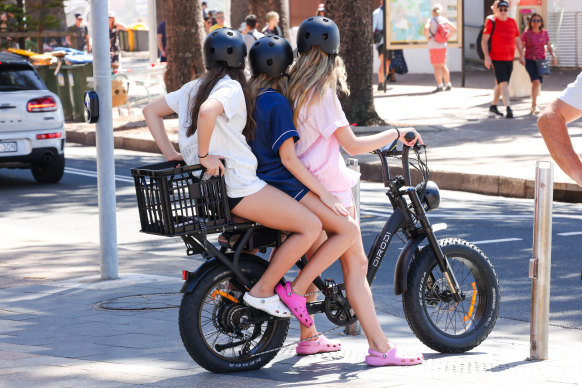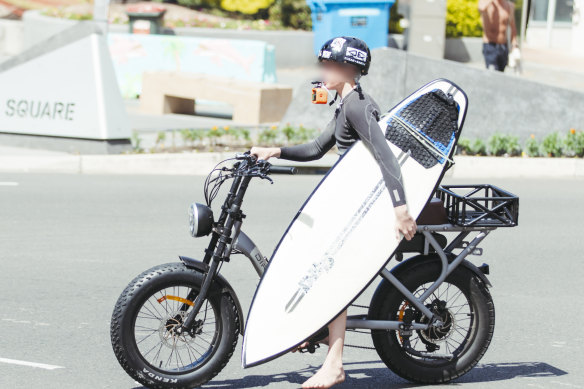This was published 6 months ago
Opinion
Are we waiting until someone is killed before we ban the illegal fat bike?
Pat Stringa
Letters editorI saw it barrelling towards me, a few hundred metres away on the footpath. Wide, black, metallic, with a small human on its chunky seat. The fat bike and teenage rider whooshed past me. “Slow down!” I shouted at his wake, but he was already a hundred metres down the street – far enough to justify my concern at how fast he was travelling, not far enough that I couldn’t see the middle finger he was brandishing at me.
Not everyone is fortunate enough to avoid these fast-moving, unregistered motorbikes masquerading as e-bicycles, known as fat bikes because of their weight (50 kilograms), dimensions and chubby tyres. Recently, a stroll on a Caringbah street turned into a nightmare for mum Clara Ferrer-Paxtot and her three-year-old son, when a teenager hurtling down the footpath on a fat bike struck the child, leaving him with a broken leg.

No pedalling is necessary on illegal fat bikes.Credit: Edwina Pickles
Last summer, fat bikes hit their peak in Cronulla where I live. They also reached plague proportions in coastal communities along the eastern seaboard. Children as young as 10 were riding the electric bikes, sometimes with friends onboard, often without helmets, on roads and shared paths. Adults were taking family on outings, with two toddlers as pillion passengers. Teenagers carried surfboards under one arm, scooting down roads at high speed.
As their numbers have grown, locals from the Gold Coast to Torquay have complained to councils and police about fearing for their safety, but to date, the response by law enforcement has been negligible or nonexistent.
Let me clarify that people worried about the proliferation of fat bikes are not members of the Fun Police. Many, like me, ride a bike and are likely to be part of the greener and cleaner cities’ brigade who want fewer cars on the road. Electric or not, bikes are a great way to move around and an enjoyable way to exercise outdoors. More people on bikes equals a healthier population and environment.
But the advent of high-powered fat bikes, which – legally – can only be ridden off-road on private property, is not going to decrease the incidence of diabetes or help young people develop a love of exercise. With tricked-up motors of up to 1500watt, well above the legal limit of 500w allowed on NSW roads, many of these bikes require no pedalling. All that’s needed to reach speeds of more than 50 kilometres per hour is the twist of a throttle – also illegal on e-bikes, according to Transport for NSW. They are potentially lethal weapons driven on roads and paths, mostly by children too young to have a licence.
As e-bike sales have increased, so have the number of people presenting at emergency departments and doctors’ surgeries, according to Dr John Crozier, recent chair of the Trauma Committee of the Royal Australasian College of Surgeons. Data collected specifically on e-bike injuries is of variable quality, Crozier told me, but he is one of many in the medical field who have seen fat bikes become a “clear, present, and rising health threat straining an already heavily burdened health system”. An avid cyclist, Crozier says he fears the “light touch” regulation of fat bike sales and usage will continue to load emergency departments with an epidemic of preventable and often serious, life-altering injuries.
Sales figures for fat bikes also don’t exist because – as general manager of Bicycle Industries Australia Peter Bourke explains – the majority of fat bike brands are not members of the national bike industry association as they feel “they are a different market”. Bourke says the lack of law enforcement could rest with the confusion created by the seven different legal definitions of e-bikes across the country and inconsistent rules around the importation, sale and use of e-bikes.
Bourke stresses we need to make sure all bikes, including fat bikes, are part of the solution and not adding to the problems we already have on our roads and paths. “If we are talking about e-bikes, they’re great,” he says. “But the fat bikes we’re talking about are not e-bikes. They’re un-roadworthy motorbikes, driven by unlicensed riders.“

Fat bikes are motorbikes masquerading as e-bikes.Credit: Dion Georgopoulos
The situation becomes more fraught with warnings from insurance experts that parents could have to pay for injuries to anyone involved in a crash, potentially losing their home because their $20 million personal liability in contents insurance won’t cover injuries sustained as a consequence of a crash on the illegal bike.
Solutions do exist: one possibility can be found within existing law. The fat bike belongs in the moped classification within Transport for NSW regulations, which would require registration, riders would need a licence and be covered by CTP insurance. The bike would be removed from footpaths and cycleways, and it would be illegal for children under 16 to ride.
Pedestrian Council founder Harold Scruby, who has been working in road safety for 30 years, says he has never seen anything as dangerous as the current situation. He is outraged there is no enforcement of the law, describing it as “pure and unadulterated anarchy” on roads, footpaths and shared paths.
We know that police and law enforcement resources are overburdened, but we need to protect the safety of all our community members; the vulnerable, the healthy and the young. The law exists to protect us all. Let’s encourage more people on bikes, but let’s not wait until someone is killed before we ban the illegal fat bike.
Pat Stringa is the Herald’s letters editor.
Get a weekly wrap of views that will challenge, champion and inform your own. Sign up for our Opinion newsletter.